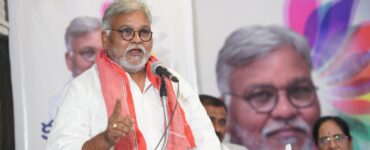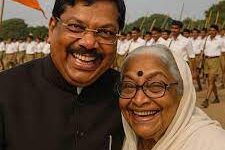The moment we think of Tamil literature our minds get illuminated by the magical musings of the poets of the Sangam period. The three Sangams that lasted for about 9990 years, reflect in their abundant creativity the two broad divisions of literature, namely akam and puram , i.e, love poetry and poetry of society or war. Tolkappiyam the earliest work on linguistic and literary principles in Tamil was the precedent in style and framework for the Sangam poets and it illustrated the difference between the Akapporul and Purapporul. The poets that sang about the ‘garlands of koodal flowers’, ‘the perfumed soft, smooth sweet body of fiancé with hair entwined with petals of the lily’ stand on a different pedestal when compared to the poets who sang about the valour and duty-minded nature of a son.
Jainism that dominated the Tamil region produced a number of didactic works and had its major literary contribution in Tamil before the explosion of Hindu devotionalism. The Tirukural is the very best of these works by far. However as it was religious in nature, only the educated could read and enjoy.
The Hindu religious renaissance of the 7th and 10th centuries A.D was one of the chief forces that resulted in mass uprising against feudal powers and in spiritual egalitarianism. As in the other parts of the nation, poet-saints of this period wandered and sang of their love of god, and of their passionate devotion to God in the colloquial vernacular. These saints appeared from various sections without any caste or community or gender barriers – ranging from brahmin priest to farmer to thief, inclusive of both men and women.
These devotional renderings were the earliest form of poetry in the historical past. The songs of the Vaishnava Alvars and Shaiva Nayanars became the voice of the Tamil people for over one thousand years, and have continually remained a vibrant part of the Tamil personality, and also as an expression of the life of Tamil culture. The Nalayirativviyapirapantham (“Four Thousand Divine Compositions”) lasted its influence on the Tamil society and psyche of the poets.
The roles of the intellectuals, politicians, and litterateurs had a cumulative effect in conditioning the transition of Tamil literature into its modern phase. The three Avvaiyars, wise women, from the 3rd century BCE to the 4th CE, Ponmudiyar, Velliveedhiyar wrote about philosophical truths of life and feministic psychological thoughts. After women’s participation in the age-old Tamil tradition of classical literature, it was only in the twentieth century that the female voices appear to have chosen an overt language of poetic era. A closer look at the Tamil poetry reveals the marginal status experienced by women in the literary canon.
The evolution process of the new poetry underwent three stages in Tamil. The important names to be considered here are Arumuga Navalar, P. Sundaram Pillai, Ramalinga Adigal, C. Subramania Bharathi, popularly known as Bharathiar, Periyar E.V. Ramasamy, the popular leader of Self-Respect movements and Dravidian political parties, and Bharathidasan, a poet of eminence.
Some are of the opinion that from the emergence of the Poet Bharathi (1882-1921) on the literary scene the new poetry originated. But we should not forget the contribution of Ramalinga Adigal (1823 – 1874), P.Sundaram Pillai (1855–1897) and Periyar Ramaswamy (1879 –1973).
Ramalinga Adigal, who is known as Vallavar, sang of the ultimate ideals of mercy, compassion and pity in simple verses that are in the form of folk music and he declared that they are ‘hymns divine’.
Sundaram Pillai had his grounding in Tamil language and literature and in Saiva Siddhantha. He introduced the features of modern verse into Tamil literature. In his dramatic poem Manonmaniyam (1891) Sundaram Pillai had introduced a novel feature to the invocatory verse by writing a ‘prayer to Goddess Tamil’, which has since then been a representative model in Tamil literature, in which Sundaram Pillai paid homage to Goddess Tamil in a diction that was charged with emotion and ecstasy. His five-act drama strongly emphasizes on societal advancement by the association with Tamil language and culture. His ideals are symbolically presented in the liberty of the heroine Manonmaniam with the help of Purushothaman, a Chera king, endowed with wisdom and heroism. He strongly denounced the Manu Code which promulgated the division of the society on the caste lines and hails Tiruvalluvar’s ideology of every one being born equal in birth.
The appearance of Periyar E.V.Ramasamy during the early the 20th century on the socio-cultural scene of Tamilnadu is a significant turning point in the history of Tamil creative writing. His contribution to the construct of Dravidian ideology—with loyalty to Tamil culture, love for Tamil language and literature, and shunning of Vedic Brahminism—was made complete with the writings of Bharathidasan and C.N. Annadurai, under the influence of Periyar’s social vision
Walt Whitman’s Leaves of Grass and Bharathi’s prose-poetry influenced Pichamurthy and it is he who declared the era of new poetry open. In the 1930s and 1940s Pichamurthy, followed by Ku. Pa. Rajagopalan, Vallikkannan, etc. was responsible to make the ball rolling well. These writers concentrated only on breaking the barriers of prosody. Their orientation on the content was less.
This was the first stage. In the second stage, after 1945, the new poetry began to evolve further and to grow in all dimensions.
In Tamil putukkavitai, vacana-kavitai, uraiviccu, corkolam, uraippa, nirvana-kavitai, vidunilaippa, peccunilaippa, etc., are the various forms of verse. As far as modern Tamil literature is concerned it is very difficult to draw a demarcating line between the free-verse and the prose-poetry. They overlap each other. However, modern Tamil poetry, too, is a vigorously thriving part of Indian literature, especially since about 1959 when the `New Poetry’ movement was launched in Madras by C.S. Chellappa’s review Writing .The modern poets united themselves in different groups and developed the literary movements. In this context, special mention must be made about the Vanampadi Movement. Poets who wrote poems in the traditional way also have shifted to write in the novel way. Darumu Sivarainan, T. S. Venugopalan, Vaideeswaran, Mani, Sundararamasamy, T. K. Duraisamy, Gnanakkuthan, etc. contributed liberally.
People began to know more about Tamil poetry through the translations of A.K.Ramanujan into English. Fifteen Poems from a Classical Tamil Anthology (1965) was published from the Writers’ Workshop, Calcutta. It was followed by a complete translation of love poems from the Kuruntokai, The Interior Landscape (Indiana University Press, 1967) reflecting the romantic moods and situations to the physical milieu and environment of the Tamil original.
Since 1970s a gradual change occurred in representing women’s voices. The publication of poems and anthologies by R.Meenakshi and Sugatha Subramanian ushered in a notable change in women’s contribution.
Meenakshi appeared during the initial phase of modernism in Tamil women’s poetry. Her poetry stands as an expression of resistance to the traditional oppression of women, and constituted a new voice in the Tamil milieu. Her poems on nature, love and friendship are as meaningful as her poems about the miserable world of the downtrodden, changing values, and angst and anger at dis-harmony. Her poems, whether they are feminist poems or songs of personal relationships, display a universality that makes her readers relate instantly to her personal self. Initially, Meenakshi’s poetry was modelled on that of the Sangam poets, whose poems tend to be cryptic and mostly descriptive of nature. Later, Meenakshi’s interaction with people and places outside her familiar circle enabled her produce poems of revolt against situations. Then came poems on social issues, women, children, and war. After her exposure to the poetry on the international scene, she does away with frills and ornamentation. And almost always, the poems project her keen sensitivity, culminating in the ‘yoga of her private inner self with the universe’.
We can cite the period when the poems of Perundevi and Rishi began to be read widely as the second phase in women’s writing. Perundevi and Rishi wrote poems distilling poetic language and inherent theme into an experimental form. It may even be said that through their work, the language of Tamil poetry brought a new kind of centrality to the new form. Perundevi and Rishi gained recognition as poets who, while challenging the poetic diction of contemporary writers of that period, functioned as part of the mainstream without claiming a separate identity.
By 1985, a more comprehensive selection by A.K.Ramanujan, Poems of Love and War: from the Eight Anthologies and the Ten Long Poems of Classical Tamil (Columbia University Press, 1985), which attempts to represent the entire corpus of ancient Tamil literature, was published. His sensitivity to the nuances of the English language and its idiom has contributed in no small measure to his success. Many of his translations communicate and stand independently as poems in English.
In the next phase, Tamil women’s poetry was dominated by poets who propounded the politics of the body. Among these, Sukirtharani, Salma, Malathi Maithri and Kutti Revathi gave expression in their poems to a voice that had perceived and grasped the repression practised on the body through religion and caste.
Malathi Maithri (born 1968) recognised as a distinguished poet in contemporary Tamil is a writer, activist and feminist. With the influence of Periyar E. V. Ramasamy, her poems allude to gender issues as a recurrent theme, and they are transgressive in style. She has decided to employ aggressive rhetoric in her publications and activism, described as “vaginal politics”. Maithri has been the recipient of the Tirupur Tamizh Sangam Award and the State Award for Poetry by the Government of Puducherry. She is also the founder of a publishing house called Anagu (transl. woman) which has translated works of Nigerian writer Chimamanda Ngozi Adichie such as ‘Purple Red Poppy’ and ‘We Should All Be Feminists’.
Ilavenil Meena Kandasamy (born 1984) represented India at the University of Iowa’s International Writing Program. She uses poetry for her activism. As a writer, Meena’s focus was mainly on caste annihilation, feminism and linguistic identity. She says, “Poetry is not caught up within larger structures that pressure you to adopt a certain set of practices while you present your ideas in the way that academic language is” and thus, prefers to use it for her activism. In an interview with Sampsonia Way Magazine, Meena said “My poetry is naked, my poetry is in tears, my poetry screams in anger, my poetry writhes in pain. My poetry smells of blood, my poetry salutes sacrifice. My poetry speaks like my people, my poetry speaks for my people.”
Dr. S. Revathi known popularly as Kutti Revathi is a lyricist, poet, activist and a doctor. Revathi received several awards and grants and she is a strong representative of women and their problems. Kutti Revathi’s second book, Mulaigal published in 2002, evoked a storm of protest and stirred controversies. However she explained, “My aim is to explore ‘Mulaigal’ (breasts) as an ‘inhabited’ living reality, rather than an ‘exhibited’ commodity.” In 2007 the English translation of her poetry Body’s Door was released. Shattered Boundaries, another collection of her poems in English translation was released in 2012.
These poets described in their poems, with unimpaired aesthetics and undiminished linguistic richness, body parts and the instances where these body parts became politicized. Poetry in this phase was besieged by opposition from all sides — Tamil nationalism, cultural police, media hostility, and even direct attacks from contemporary male Tamil writers.
The present stage is the third stage in which N. Kamarasan Meera, Abdul Rahman, Abi, Kalapriya, Sirpi, Puviyarasu, Mettha, Gangaikondan, Akkiniputtiran, Sakthikkanal, etc. are contributing devotedly. They have introduced a number of poetic techniques. The focus on the content and form is well seen. Thus the Tamil poetic fabric displays tradition and culture, suppression and revolution in rich colours of dazzling patterns.
*









A very comprehensive and informative piece. There is a passionate underlining and sensitivity – towards literature per se and the need for an evolving approach and effort in contemporary literature. I must admit, I really, and pleasantly, warmed up to the gender aspect of the piece. Very well written.
Sir we are happy to read your detailed observation. You inspired us!
They wrote well about Tamil poets with clear cut observations and gave analysis on them. Different opinions and ideas about them , and shared their ideals,it’s great effort. We acquired wisdom from them through their contribution. Really it is one of the spice of reservoir of abundant knowledge to us.A.k.Ramanujan,Malathi maithri,and three great spiritual poets Ramalinga adigal, Sundaram Pillai,Ramaswamy Periyar act threemoorthulu in those period and spreads enlightenment to all.Great work done by only great writers proved from this noble work,thank u sir
Tjanks Madam
Complex mosaic made simple, interesting and informative. Congrats.
Sir thank you for the observation.